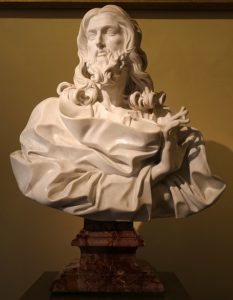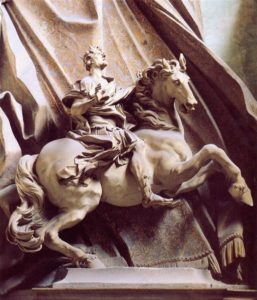
Salvator Mundi by Gian Lorenzo Bernini (photo courtesy of Sailko)
Fiumicino is a small town located about 45 minutes west of the center of Rome. To Romans, Fiumicino means one of two things: the beach or the airport. The Leonardo da Vinci Airport in Fiumicino is where nearly 30 million people per year arrive when flying into Rome. Though it’s named after one of Italy’s greatest artists and located less than 20 miles from the Colosseum, Italy just has to show off even more of its beautiful culture as soon as you land in the capital. Earlier this week, at Fiumicino Airport’s terminal 1, Italy’s Interior Ministry put on display the work of another one of its great artists, the baroque sculptor Gian Lorenzo Bernini.
Bernini created Salvator Mundi in 1679, and today it is considered his last great work completed before his death a year later. It is a marble bust of Christ with his right hand extended in benediction. Bernini is intimately connected to Rome, and his work is visible throughout the capital. Whether you are an art historian or just a fan of the book Angels & Demons by Dan Brown, you’ll know that the city is dotted with Bernini’s sculptures, whether it’s inside churches, outside in the piazzas, or within the museums like the Galleria Borghese. And now, to promote Italian arts and culture, the bust is sitting in a glass display case across the terminal from the Eataly outlet.
Bernini died of a stroke in 1680, leaving Salvator Mundi to his friend and patron Christina, Queen of Sweden, who had been living in exile in Rome for the past twenty-five years. After her own death, Christina passed the bust on to the pope, Innocent XI, who would outlive her only by four months. After that, Salvator Mundi stayed with the Odescalchi family, of which Innocent XI was a member. Then, in 1773, the sculpture disappeared. Only a few written descriptions and a single drawing of the work remained. In the 1970s, American art historian Irving Lavin hypothesized that a sculpture in the collection of the Chrysler Museum in Norfolk, Virginia matched Salvator Mundi’s description and, therefore, might be the original work or the one recorded copy. After learning that Sées Cathedral in Normandy owns another version of Salvator Mundi, Lavin and some of his colleagues were convinced that the Chrysler Museum version was the original Bernini while the Sées version was the copy. It was only in 2001 that people finally realized that the original version of Salvator Mundi had never left Rome at all.
That year, an exhibition in Urbino dedicated to Pope Clement XI included a photograph of a marble bust of Christ in its catalog. According to the researchers, the bust sits at the pope’s family’s chapel at the Church of San Sebastiano fuori le mura in Rome. This catalog gets into the hands of Francesco Petrucci, an Italian architect appointed custodian of the Palazzo Chigi, one of Rome’s palaces and the prime minister’s residence. Petrucci had been involved in Lavin’s debates on the Chrysler and Sées version of Bernini’s Salvator Mundi, so he was familiar with how the sculpture was supposed to look. Seeing that the exhibition researchers had attributed the work to another sculptor of inferior skill, Petrucci headed to San Sebastiano to see the work for himself. That’s when he realized this was, in fact, the work of Gian Lorenzo Bernini himself. Experts now theorize that the sculpture was likely removed from the Odescalchi Palace and moved to the church during the Napoleonic Wars. The year after its rediscovery, art historian Maurizio Fagiolo dell’Arco wrote that while the debate on its authenticity remained open at the time, the fact that Christ’s hand appears nearly identical to the hand of Bernini’s statue of Constantine in the Vatican is just one point of evidence in the San Sebastiano version’s favor. The hand on the Chrysler version seems flat and lifeless by comparison. Even Irving Lavin conceded that the Chrysler version is just, in fact, another copy.
Removing Salvator Mundi from its normal environment and placing it in a display case in the middle of an airport terminal may be a little inappropriate, perhaps. Of course, the goal of promoting Italian arts and culture to incoming visitors is understandable, but was this the right way to go about it? Most tourists visiting the country are there explicitly to experience Italian art and culture. So, I’m not sure they’ll need any more prompting by making sure you see a Baroque masterpiece the moment you step off the plane. But regardless, even if you have a layover at Fiumicino, you can tell everyone that the airport had a little more than a duty-free store and a Hudson Booksellers.

